Still life of the great maystrіv. Beautiful still life
Yaka is a marvelous painting - still life: there is a wondrous copy of quiet speeches, the originals of which are not fond of.
Blaise Pascal
I really, having overshadowed the Chi Ti, if you didn’t look at the fruit from the kitchen table? Well ... hiba, if you're hungry, right? And the axis of a picture with a fruit composition or a rosy bouquet of quotes can be seen in years. The magic of a still life is very special.
At the crossbar from the French movi still life means "Dead nature"(Nature morte). However, there is no longer a fair transfer.
For good reason still life- the price of the image of the unruly, caught objects (apartments, vegetables, fruits, furniture, kilims, etc.). The first still lifes are painted on the frescoes of the Ancient Greece and Ancient Rome.
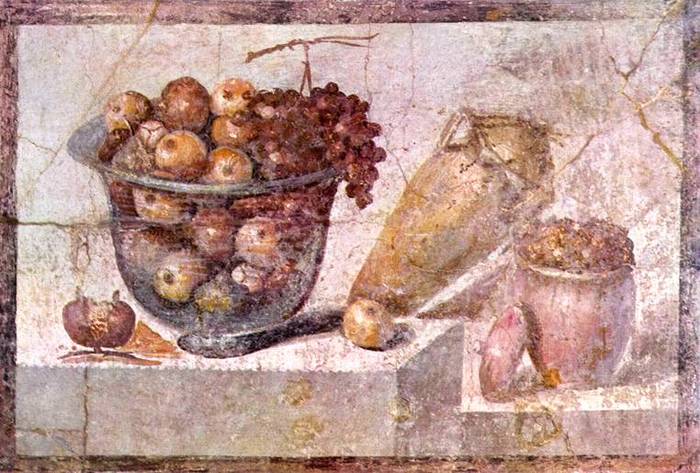
Still life (fresco from Pompeii) 63-79 r, Naples, Capodimonte National Gallery. The author of nevidomy.
If you come alone to a Roman guest, the rules of good taste are vimagali, and the gentleman will show you a little crockery of his own. With the tradition of yaskravo depicting a still life from the tombs of Vestor Priska in Pompeii.
At the center of composition there is a vessel for mixing wine and water, attracting the god of love Dionis-Lieber. Glaciers, scoops, wine horns are symmetrically arranged along the sides on the golden table.
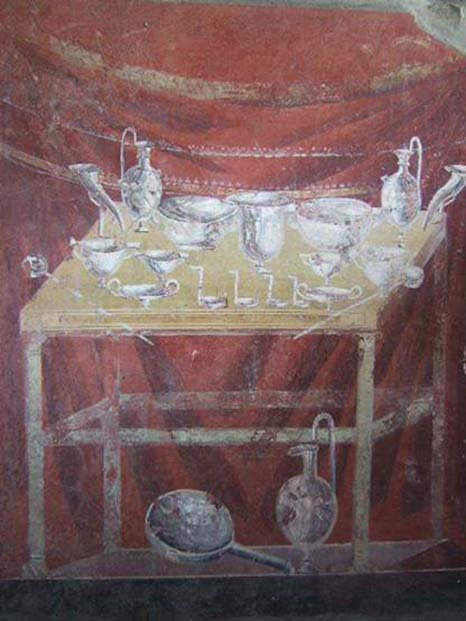
However, a still life is not just fruit, vegetables and kits, but th ... a human skull, nods to visualize a sharpness human life... This is how the still life was represented by the celebrities of the “vanitas” genre, the representatives of the early stage of the development of still life.
Vidatny butt - allegorical still life of a Dutch artist Villema Klasa Hedi A pipe is depicted with a skull - a symbol of the imperceptibility of the earthly malad; I will swallow a vessel - a depiction of a cry of life, a key - a symbol of the possession of a housekeeper who manages stocks. There is no symbolism of life, and the brazier, in the ice of the chew of a vugilla, means її zgasannya.
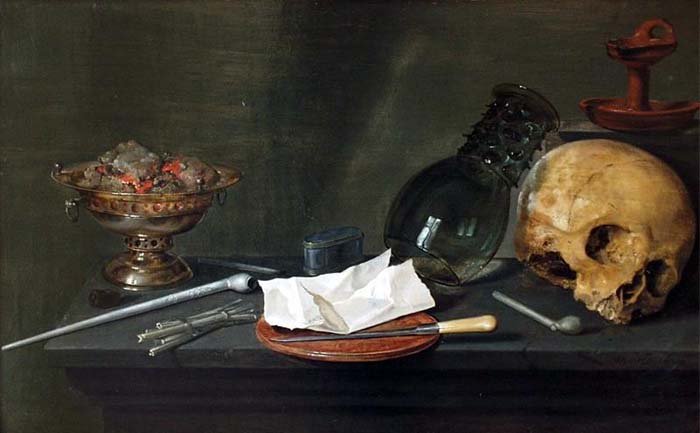
Vanity. Vanitas, 1628, Willem Claes Heda.
Willem Khedu is rightfully called "Maystrom snidankiv". Behind the help of the central arrangement of the kitchen, the artist marvelously accurately conveys the settings of the paintings. And the vastness of the image of the glimpse of light on the ideally smooth surfaces of the middle bowls and the cups of the cups was inimical to the artist's contemporary fellows.

Neymovіrno, nіkіlki accurately and delicately Heda vmіv to convey the skin of the hand: the gru of light, the particularity of the form, the color of the objects. All Dutch paintings have tameness, poetry, broader than the drowning of light objects.
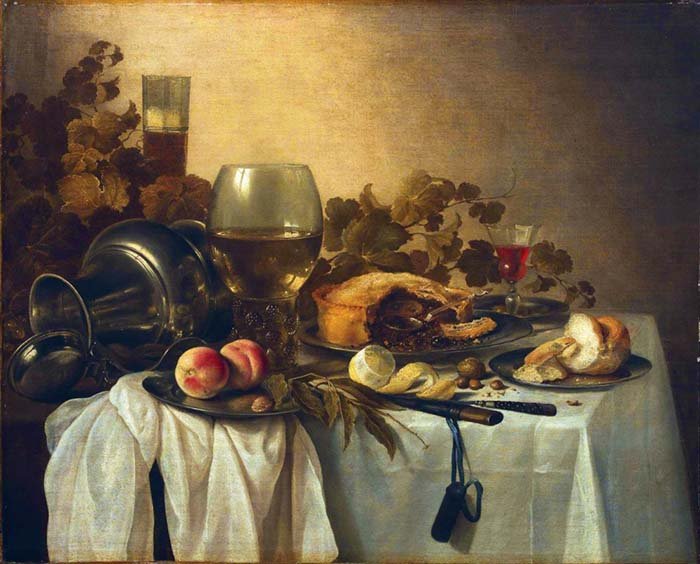
Still life of the house of artists
Still life was often choked with famous artists... I tell Tobi Dal about the maystrіv of penzel and about їkh miraculous creatures.
Pablo Pіkasso - svitu painter
Unique and unrepeatable - the very name of the prominent Spanish artist of the XX century. Pablo Picasso. The skin of the author's robot is a tandem of the original idea and geniality.

Still life with a bouquet of kvitiv, 1908 r

Still life with cibulins, 1908 r
Krym traditionally young, realistic, reminiscent of light and bright farbs, or even frowning, vikonanyh in blakit-blue tones of still lifes, Picasso bursting cubism... The artist has placed objects or heroes of his paintings on other geometric figurines.
I wish the artisans did not recognize Picasso's cubism, at the same time their robots are selling well and be bestowed upon the most popular collection of light.

Gitara i notes, 1918 p
Eccentric Vincent Van Gogh
From the famous "Dawn at Night", a series of paintings with sleepyheads became a unique symbol of Van Gogh's creativity. The artist planned to decorate his house with sleepers in Arles until the arrival of Paul Gauguin alone.
“Heaven is a wonderful blakite color. Sleepy promenade - blido-zhovtі. Tse m'yake, enchanting the heavenly blakity and the tones of the paintings by Vermeur Delft ... I can't write this more beautifully ... "- acclaimed saying Van Gogh. You can, the artist himself painted the sleepyheads an unlimited number of times.

Vase with 12 sleepers, 1889 rub
The unpretentious cohannia, the vigilance and rejection of his creativity, propel the artist to the divine spirits and the unabated give rise to health. Ale about the painting of the talanovitiy, the artist lightly wrote: "If I go down ninety-nine times, I'll go all the same for the hundredth time."

Still life with red poppies and chamomiles. Over, worm 1890 rub.
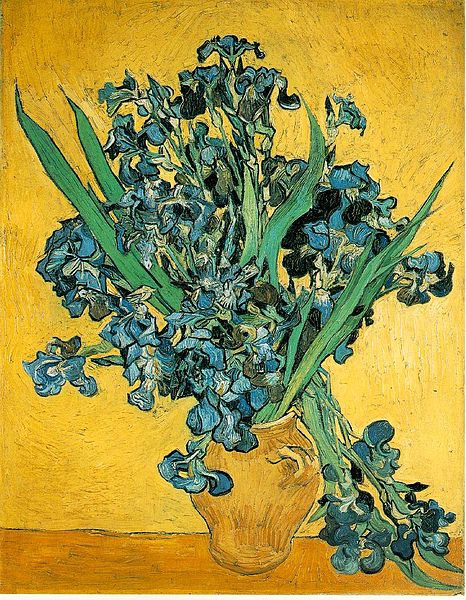
Irisi. Saint-Remy, travene 1890 r
Complex still life by Paul Cézanne
"I want to turn nature's vitality",- the great French artist Paul Cezanne loving repetition. The artist has imaged a vipadkovu gru of light and tіnі, not to change, but postіynі characteristics of objects.
Pragmatically show the objects from their sides, describe them in such a way, for the eyes of the eyes to be pleased with the still life, are dumb with small kutas. Mi bachimo washed from the top, the tablecloth and fruit - from the side, the box in the table - from the bottom, and the glechik - from the other sides at once.
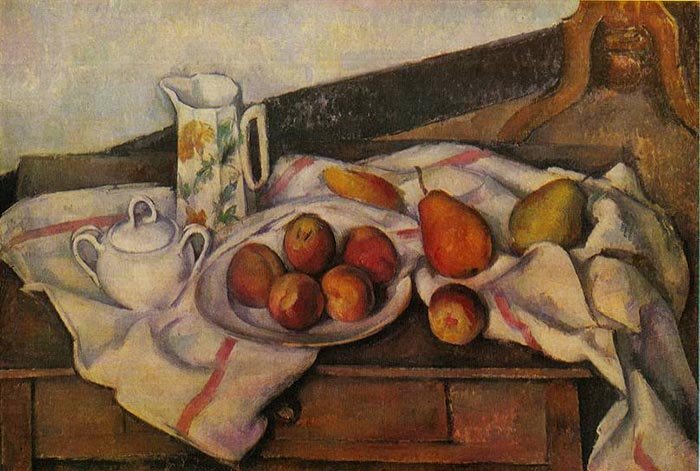
Peaches and pears 1895 rub
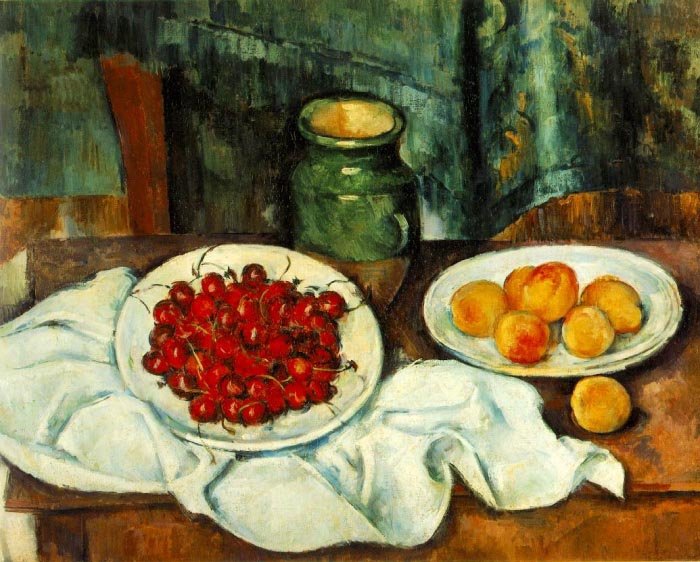
Still life with cherries and peaches, 1883-1887 rr.
Still life of lucky artists
The palette of colors and the most versatile views allows the still life to reach the neural realism and beauty of the still life. Do you want to have mercy on hostile pictures of talented fellows?
British Cecil Kennedy
From the paintings of the artist's painter it is unfortunate to see - the walls of the enchanting flower! Hmmm ... Wait, I can still smell the cichs of divinely garnished apartments. What about you?

Cecila Kennedy is rightfully named the most renowned British artist of passion. Volodar has received a number of prestigious awards and a favorite of the "strong world", Kennedy has become a vidomim only if he has been well over 40.

Belgian artist Julian Stappers
See about the life of the Belgian artist Julian Stappers mіzernі, which cannot be said about his paintings. The artist's life still lives - in the collections of the most popular people.

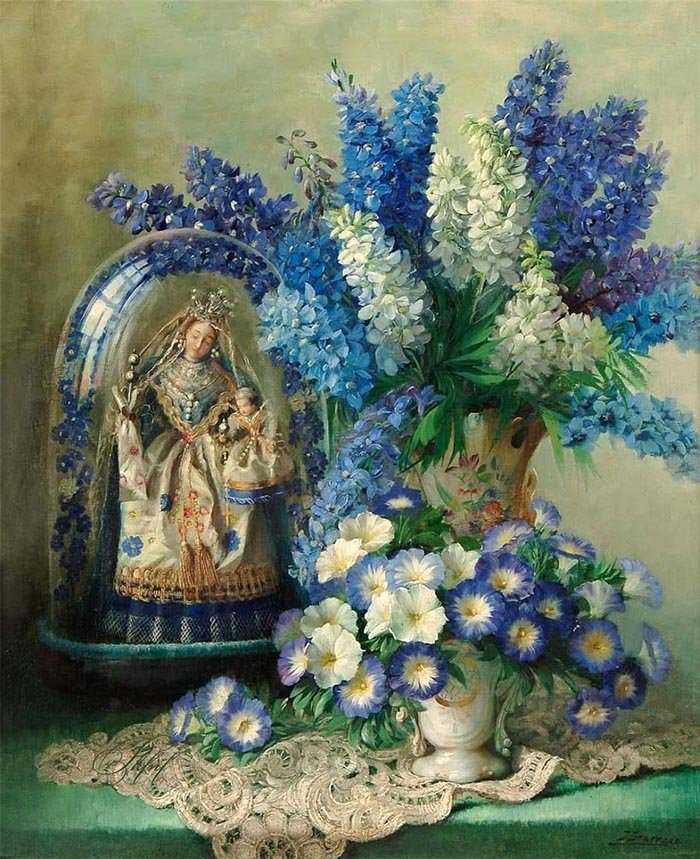

Gregori Van Raalte
The freakish American artist Gregor Van Raalte especially respects the beast for the light and the tin. An artist of perekonivaniye, so the light is guilty of falling not directly, but through the forest, the leaves of the trees, the dusts of the windows, or seeming from the surface of the water.

The Talanovitiy artist lives in New York. Enjoy painting still lifes in watercolor technique.

Iranian artist Ali Akbar Sadekh
Ali Akbar Sadeghi is one of the most successful Iranian artists. In their robots, there is a master of the same compositions of traditional Iranian paintings, a Persian cultural myth with an iconography and a painting of art.


Still life of lucky Ukrainian artists
Do not think, but in the Ukrainian maystras of Penzlya there is something unique, unique to the magnificence of a still life. I will bring you to the table at once.
Sergiy Shapovalov
Sergiy Shapovalov's paintings are lined with sleepy bunnies. Kozhen yogo is a masterpiece filled with light, good and love to old earth... And the artist was born in the village of Ingulo-Kam'yanka of the Novgorodkiv district of the Kirovohrad region.

Sergiy Shapovalov - Honored Artist of Ukraine, member of the National Union of Artists.

Igor Derkachev
Ukrainian artist Igor Derkachev was born in 1945 in Dnipropetrovsk, de living at a time. Twenty-five rockets were brought into the art studio Budinka of culture for students. Yuri Gagarina, a couple of yak students, and then in yakosti vicladach.
The artist's paintings are pierced with warmth, love to ancient traditions and gifts of nature. The warmth is especially warm through the paintings of the author to be transferred to all shanuvalniks of his creativity.


Viktor Dovbenko
Behind the words of the author, his still life is a mirror of vlast's senses and moods. In bouquets of Trojands, hairs in roses, Aistr and Zhorzhin, in "zapashnye" fox paintings - a unique natural aroma and unimaginable gift of the rich nature of Ukraine.
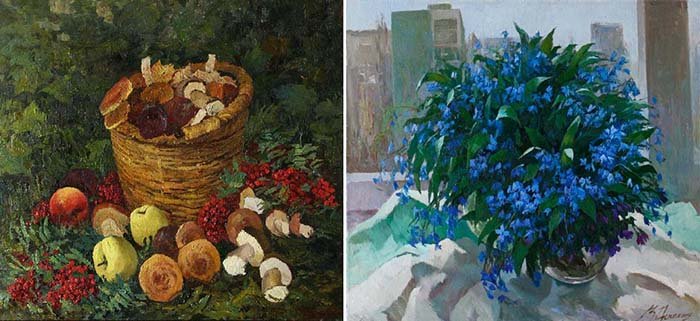

About the deyakі of significant artists, scho they put pictures in the genre of still life.
Entry
The term "still life" is used for the definition of paintings, for depicting inanimate objects (in Latin "nature is dead"). Moreover, it can be like a natural prodigy (fruit, quiches, dead creatures and coma, skulls and others), as well as people (new stuff, old man, books and suve paper, jewelery embellishments and so far). Most often, a still life includes a deyak of prikhovykh pіdtext, transmissions through symbolic images. Robots of allegorical character are introduced to the "vanitas" pidzhanru.
Still life as a genre having adopted the greatest development in Holland in the 17th century as a way to protest against the official church and the introduction of the religious mystery. At some other history, the painting of the robots of the Dutch at that hour (Utrekh, Leiden, Delft and others) celebrated a majestic infusion on the development of art: composition, perspective, symbolism as an element of information. Unimportant to its significance and interest from the side of the public, to the thought of academies of the arts, still life has taken over the genres of the old world in the foreign history.
Rachel Ruysch
Ruysch is one of the most popular Dutch realism and still life authors. The composition of the artist's society is to revenge the mass of symbolism, moral and religious powers. This formal style is a combination of a dark background, board-based adjustment of details, low-level drawing and images of additional ones, which give interest, elements (comas, birds, reptiles, crystals).
Harmen van Steenwijk
The robots of the Dutch realist perfectly demonstrate still life in vanitas style, showing the essence of earthly life. One of the most famous paintings is "Alegoria of Marnoslavstvo of Human Life", in which a human skull is shown in the openings of the sleepy light. The development of objects and composition leads to the idea of non-gateway physical death. The detail and the level of realism of Stenweik's paintings can be reached for the display of thin brushes and the technique of applying farbi.
Paul Cezanne
With his landscapes, portraits and genre creators, Cezanne made a contribution to the development of still life. For that, as an interest to the impressionism of missing, the artist, having seen fruit and natural objects, experimented with large figures. Tsіslіdzhennya helped to establish the perspective and obsyag in still lifes not only for help classic methods, And on the way to the maister vicoristanny koloru. All are glanced straight at Cezanne in a fake boule before the birth of Georges Braque and Picasso with the development of analytical cubism. In the case of persecution, the process of creating a still life is trivially trivial, bringing the fruit and vegetables to the point of repairing the rotting and packing back to the completion of the painting.
Hem
The scholar of David Baiyi, Dutch realist Hem sees miraculous still lifes with a great number of details, nesting compositions, a great number of comas and some decorative and symbolic elements. Frequently the artist vikoristovuvav in robots relіgіynі motives, similar to Jan Bruegel and Federico Borromeo.
Jean Baptiste Chardin
Sin Tesli Jean Chardin, adding his skill and craving to the order of the very father. The paintings of the maister are often spokіynі and tverezі, and even winnuv to the harmony of toni, colori and form, plenty of opportunities for robots to reach with illumination and contrasts. The bazhanna of purity and order also rotate around the day in the compositions.
Frans Snyders
The author of still lifes and scenes with the creatures of the era of the Baroque, he is a nameless maister, and his building is to depict the texture of the shkiri, khutra, slope, metal and other materials, which is not overturned. Snyders Bouv is also a prominent animist, often depicting dead creatures in his still lifes. He became an official painter of the Archduke Albert of Austria, who was involved in an even greater number of masterpieces.
Francisco de Zurbaran
Zurbaran is the author of paintings on a religious theme - one of the greatest creators of still lifes. Made in strict Spanish traditions, it’s robotic, it’s impossible to lie down for an hour, and it’s immeasurable simplicity. As a rule, the stench is a small number of objects on a darkened background.
Conor Walton
Of the current authors, thanks to Conor Walton. The introduction of an Irish artist into the development of a still life can be cleanly patted in robots "Prikhovane: Oranges and Lemonies" (2008), "Still Life with the Great Orhideus" (2004). Pratsi maister exact and vikonanii vinyatkovy vikorystannyh svitla, which additionally helps to transfer the texture of the green surfaces.
Beautiful still life Updated: Worm 4, 2017 by the author: Glib
Moving on to the final stage of the series of posts about the genre of still life. There will be awards to the creativity of Russian artists.
For some reason, it’s Mabut z Fyodor Petrovich Tolstoy (1783-1873). Still life graphic artist F.P. Tolstoy, a seemingly Russian sculptor, medalist, painter and painter, melodiously, is the most visible and valuable part of this creative decline, the artist himself would like to say that it took an hour to create "it takes an hour for the most serious ones."

The headlong power of Tolstoy's still-life babies is the lusciousness. The artist has copied nature. Win namagavsya, for yogo with fluffy words, "With the suvorian variability of transferring from nature to the papir, copy the letter so, as it is, with the best details, how to lay down the quote." To introduce a glance into Oman, Tolstoy vikoristovuvav such an illusory priyomy, like the image of the dewdrops that napivprozorium, how to curl the little ones and do help fool the star.
Ilya Efimofich Rupin (1844-1930) also more than once turned to such a motif in a still life, yak kviti. You can bring a picture to such creatures " osenniy bouquet"(1892, Tretyakov Gallery, Moscow), de artist with a respectable image of an autumnal landscape, a young woman standing on the ashes of golden trees, and a modest bouquet with good and big flowers in her hands.

І. Rupin. Autumn bouquet. Portrait of Vira Repina. 1892 Tretyakov Gallery

The history of the painting "Apple and Leaves" is still unrecognizable. Still life, having tasted fruits and leaves, with supplies for the scientist Rupin, V.A. Surov. The subject composition of the painting was honored by the teacher, since he was able to write such a still life himself. Quests and fruits were received by artists, who volunteered from their speeches, they were the most poetic and beautiful to show the light of nature. Navit І.М. Kramskoy, zealously placed to a similar genre, also giving tribute to a still life, defective picture"Bouquet of Quites. Floxy" (1884, Tretyakov Gallery, Moscow).
Valentin Oleksandrovich Surov (1865-1911) sees us as an artist who has come to respect his creativity in the field of landscape, portrait and historical painting. However, later to respect, that the subject in his creative work has always played an important role and has taken an important role in the same place, both in equal measure and in the composition. Trochi vishche I have already guessed the scientific robot "Apple on the leaves", 1879 rocky, vikonaniy pіd kerіvnіstvom Rєpіna. As soon as the robot is painted with cheese, we will write on the same theme as Rapin, it is possible to polish, as Surov's still life is seen as a larger child, below the canvas of his teacher. Pochatkіvets artist vikoristovuvvav low point of view, to that first і other plans of madness, and the background of changes.
The painting "The Little Girl with the Peaches" goes beyond the portrait genre and is not called "Little Girl with Peaches", but not "Portrait of Virya Mamontova". We can bachiti, but here we came across a drawing of a portrait, an interior and a still life. The artist came to the same respect for the image of a girl in a rosy coffee and innumerable, albeit a group of objects. On a white tablecloth lie low peaches, maple leaf and a bright knife. Lovingly scribbled and іnshі speeches, how to be in the distant plane: style, great porcelain tarіlka, how to embellish the style, figure of an іgurishkogo soldier, svіcnіr on pіdvіkonnі. Sleepy light, look from a window and a frog on the subject of bright visuals, giving an image of poetic charm.

Mikhailo Oleksandrovich Vrubel (1856-1910) wrote: "I know me less, do not do, but feel for me that intimate national note, as I so want to play on canvases and in ornaments. Differentiated and Blidogo Go ".
In the Academy of Mistresses, we will love Vrubel's wickedness by Pavlo Chistyakov, who taught the young painter to "paint in a form" and stverdzhuvav, so that the minds are not formed in the open space with shading and contours, and then there will be lines. Zabdyaki youmu Vrubel nagged not just to show nature, but is dumb to lead with her sincerely, mayzhe love beside. In such a dusi of vikonaniyu monsters still life of the maister "Shipshina" (1884).
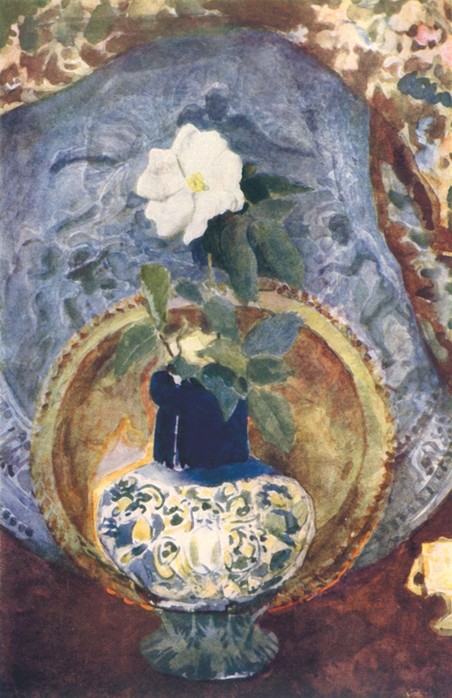
On tlі vyshukanoy draperies with quilt motifs, the artist spreads a vitoncheny rounded vase, painted with іdіd wіzerunks. Clearly see the bottom Bila kvitka sipshini, seen with blue-green cloth, and the leaves of the dewline may be angry with the darkly frivolous black gorlet of vazi. The composition of the Vicon is invisible and fresh, as the glances simply cannot fail.
At the time of the ailment, Vrubel became more writing from nature, and this little one does not appear only because of the embossing of the form, but rather an absolutely special nature. To be built, the skin of the artist's hand is like a countryman and addiction.
Especially primitive in the whole family of babies "Still life. Pidsvichnik, decanter, glass". A priceless triumph of fierce activity. A leather subject to a still life carries vibuch strength in its own. The material from which the speech is prepared, whether it be bronze pendants, the side of a decanter, or a dull display of a candle, can be seen from the colossal internal stress. The pulsation is conveyed by the artist in short, crisscrossing strokes, through the texture of the swelling vibration and stress. In such a rank, the subject will add a sensation of stinginess, in which and in the field, the essence of speeches
.
G. Teplov and T. Ulyanov. More often than not, the stench pictured a plank of a wall, on such boules there were knots and veins of a tree. On the razvishani stinks, or plugged behind the flowers nailed ribbons of decorative objects: knives, combs, sheets, books, notes. On the high-rise polichi there are year-olds, chornilnitsy, bottles, candle-holders, dishes and other speeches. To be built, with a variety of items of various kinds, but for the most part, far from it. Wonder at such a still life, you can ask about the interests of the artists, who were engaged in playing music, reading, as they were filled with mystery. The Maistri lovingly and diligently imagined dear speeches. Tsi pictures chіpayut their breadth and bezposrednіstuyu natura.
Boris Mikhailovich Kustodiev (1878-1927) also came to the genre of still life richly in his work. On these living canvases you can put on yaskravі satin fabrics, blisky middy samovars, blisk faience and porcelain chervonі shmati kavuna, grape grone, apple, delicious muffins. One of the miraculous pictures є "The merchant's wife for tea", 1918 p It is hard not to get overwhelmed by the writing of objects on the canvas. to stand in front of the merchant's wife - to add all the speeches to the image of the Christmastide mood.
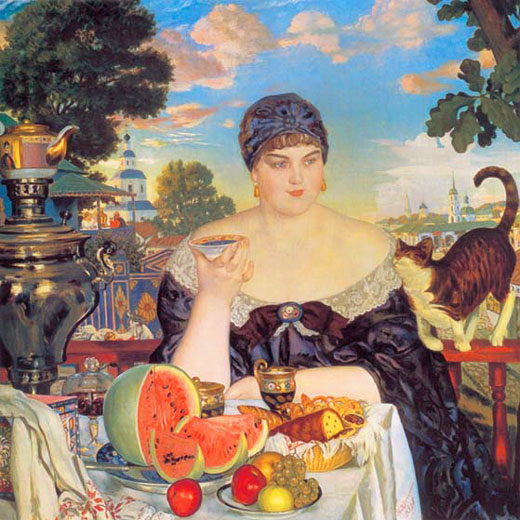
The genre of still life has a great respect for the so-called "still life-trompe l'oeil". Bagato still life - "trompe l'oeil", unaffected by those who have been introduced to the head of the headquarters in Oman, may have insane artistic merits, especially remembered in museums. Ale є here і vinyatki. For example, "Still Life with Books", P.G. Bogomolov, insertions into the illusory "bookish shafu", and not all at once to greet, as the picture would be deprived of all.
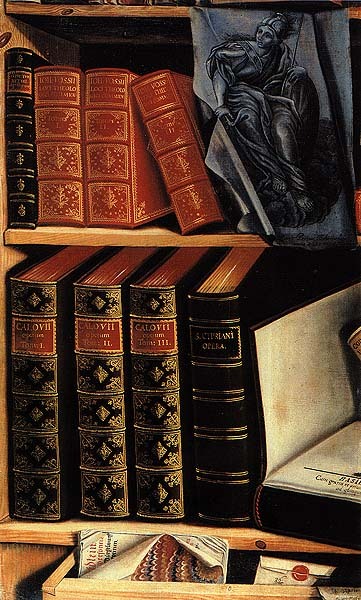
Even good "Still Life with Papugoi" (1737) by G.N. Teplova. Beyond the help of clear, clear lines, how to turn into soft, smooth contours, light, penetrating dark, subtle nuances, the artist shows different objects, developed on the boards of the wall. The tree is visibly transferred, blakytny, rozevi, zhovtі vіdtіnki which additionally help to create more real smell of fresh smell of wood.

G.N. Teplov. "Still life with papugoi", 1737, State Museum of Ceramics, sadiba Kuskovo
Russian still-life - "trompe l'oeil" of the 18th century to testify about those that artists still lacked the ability to convey space and obsyagy. It is more important for them to show the texture of objects that are not transferred to the canvas for real action. At the sight of Dutch still lifes, for speeches, glinting with a light middle, images in one place with her, in the pictures of Russian maystras, objects that are written in a more retired way, to navigate in other ways, in a simple way, in a simple way.
V cob XIX a great role in the development of a still life was played by A.G. Venetsianova, who played against the suvoriously interdigitated genres and paused to see her victories of the whole life of nature.
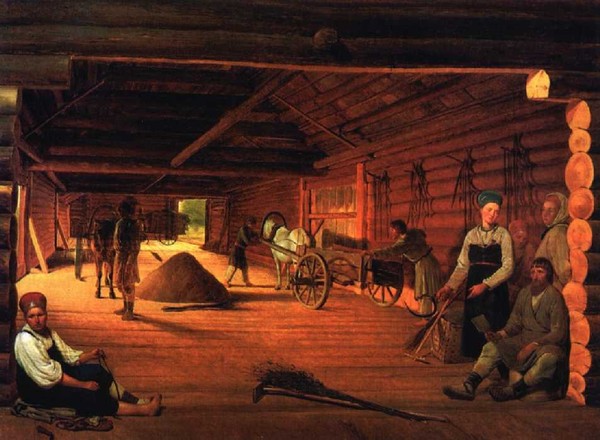
A.G. Venetsianov. Тік, 1821 - 23 r
The Venetian school has created a new genre for the Russian art - inter'ur. Artists showed the development of a noble house: living rooms, bedrooms, cabinets, kitchens, classy rooms, people, etc. In cikh creatures, the image of small objects was more important to the world, I would like the still life itself to be not represented by the representatives of the Venetsianov stake (in every case, saving even a small amount of still life, viconated by the scholars of the famous painters). Protest, Venetsianov, calling out his vikhovants, reliably opratsovuvati not only denouncing and figuring people, but the new words.
The subject in Venetsianov's painting is not an accessory, it’s wrong to wrap around the details of the picture, and often we key to a more reasonable image. For example, I would like to use the function of showing sickles in the painting "Zhentsi" (another half of the 1820s, Russian Museum, St. Petersburg). Speeches in Venetian mystery are created by students in the leisurely and turbulent life of the characters.
I want Venetsianov, completely without painting still lifes, but including the whole genre in his original system. The artist wrote: " Unliving speeches do not appeal to those noso-manic wines that are alive in the power of those objects, they stand, stand before an incomprehensible artist quietly, unruly and give them an hour more precisely and in the same time , which lies in the mind occupied by objects”.
Apparently, still life has taken on a great role in the pedagogical system of the Academy of Mysteries in the 18th-19th centuries (in the primary classes, the vikhovans robbed copies of the still lifes of the Dutch maestros), Aleksey Venetsianov, the artist, until , folds of such speeches, such as figurines, dishes, candlesticks, colorful lines, fruits and kits. Objects for the novice still lifes of the Venetians were picked up so that the stench came to the ears of the artists, the sound of the shape, the beauty of the color.
In the paintings, created by Venetsianov's talented scholars, speeches are conveyed truthfully and svizho. Such still lifes by K. Zelentsov, P.Є. Kornilova. The creativity of the Venetians is robotic, for their sutta is not still lifes, but not less, the role of speeches in them is great. You can name, for example, the canvases "Cabinet in Ostrіvtsyah" and "Imagination in the mirror" by G.V. Magpies, who are taken to the selected Russian Museum in St. Petersburg.
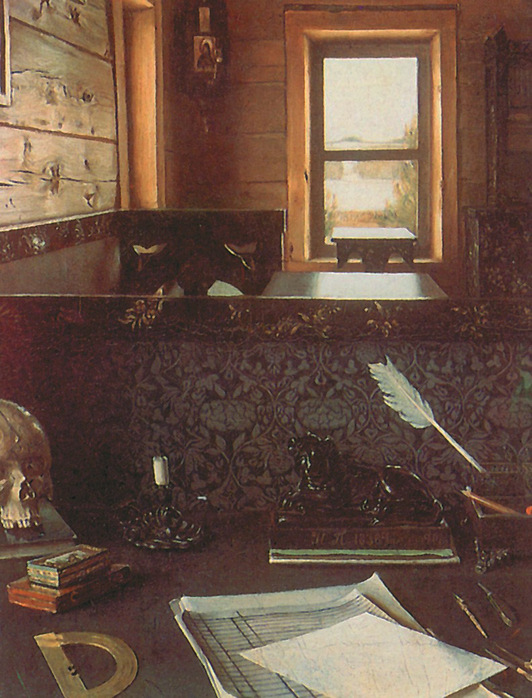
G.V. Magpie. "Cabinet in Ostrіvtsy". Fragment, 1844, Russian Museum, St. Petersburg
Still-life in cikh works does not appear independently, but as a cleverly composed by the mayor of the part to the inter'er, which is a reflection of the zealous compositional and emotional structure of the picture. The main element here is light, a soft transition from one object to the other. Wonder at the canvases, rose, naskilki tsikaviy navkolishn_y light the artist, having lovingly depicted a leather object, will find a leather object.
Still life, performances in "Office in Ostrіvtsyah", wanting and borrowing a small place in the out-of-the-way composition, to be superbly significant, seeing the reason that the author saw it in front of the big back of the sofa on the right, and on the right. To be built, oh Soroka plots have been lying on the table with objects, so they may have forgotten about the sieve of the details of the picture. The meister retired vipisav everything: a penny pen, an olivchik, a compass, a protractor, a folding knife, rakhunks, sheets of paper, a candle in a svichnik. The point of view from above allows you to see all the speeches, because they are not out of town. Such attributes, like a skull, an old man, as well as symbols of "earthly essence" (statuette, papier, rakhunka), allow deyakim presenters to zarahuvati a still life to the type of vanitas, if such a zbig is purely vipadkovo, shvid for everything, krstavim the artist quickly tables of the last ruler.
We see the mayor of subject compositions of the first half of the 19th century, the bouv artist I.F. Khrutsky, as having written a beautiful picture in dusi dutch still life XVII stolittya. Among the most beautiful robots - "Quites and Fruits" (1836, Tretyakov Gallery, Moscow), "Portrait of a Guardship with Quits and Fruits" (1838, Art Museum of Bilorusia, Minsk), "Still Life" (1839, Museum of the Academy of Arts, St. Petersburg) ...
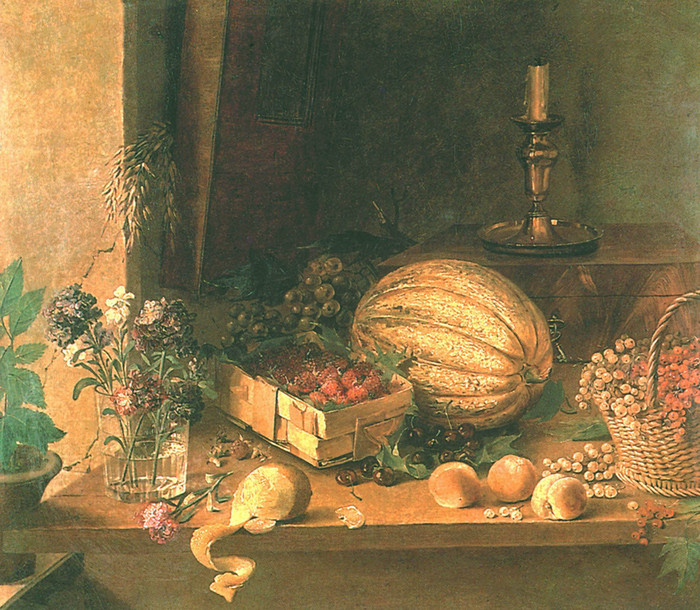
In the first half of the 19th century in Russia, the great popularity of the "botanical still life" Western Europe... At France, at all times, botanists went to create with wonderful illustrations. Great popularity with bagatio European countries having trimmed the artist P.Zh. Redoubt, which vvvazhavshis "himself glorified by the artist in his own hour". "Botanical drawing" is a significant phenomenon not only for science, but for art and culture. Some babies were given as gifts, decorated albums, with such a rank they put them on a par with other creators of painting and graphics.
In the other half of the 19th century, there is a great respect for the image of objects in P.A. Fedotov. If I do not want to paint still lifes, light speeches, pictures of them, I will flush with my beauty and truthfulness.
The objects in Fedotov's works are not from the life of people, the stench takes an unbeatable part in the dramatic podіyah, imaged by the artist.
Marvel at the painting "The Holy Cavalier" ("The Wounds of the Party", 1846), marveling at the development of objects that were written by the mayor. Spravzhny still life, amazed at its non-richness, performances on famous paintings Fedotov's "The Major's Svatannya" (1848). The slogan is clearly conveyed: fougeres on high-pitched bowls, a dance, a decanter. Naitonshe і prozore, vono nіbi vidyє lower kryshtaleviy dzvin.
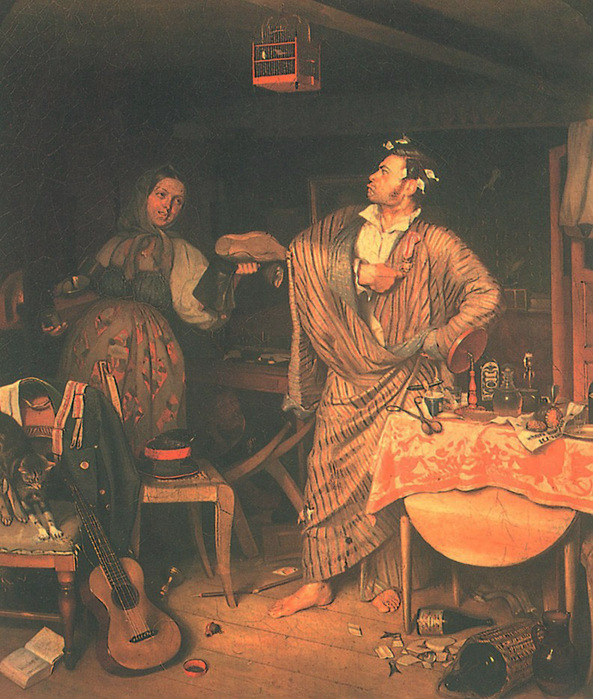
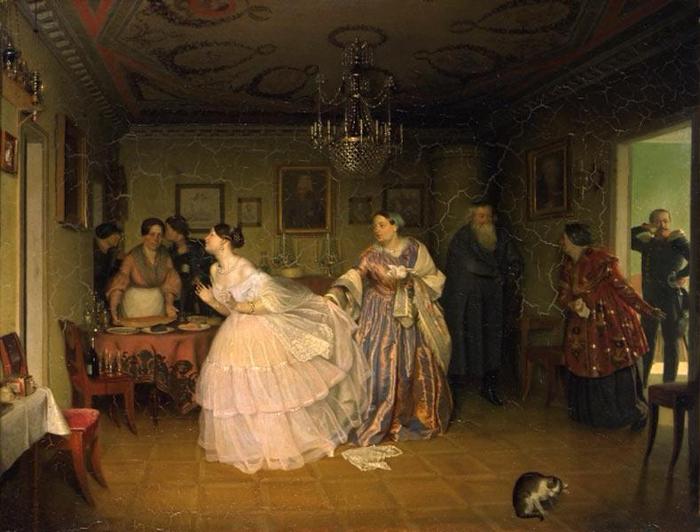
Fedotov P.A. Major's matchmaker. 1848-1849. State Tretyakov Gallery
Fedotov did not see the objects from the interior, the speech was shown not only authentically, but picturesquely subtly. Kozhen is the most extravagant, for it is not even a more comfortable object, which borrows its own place in the out-of-the-way space, to be built wondrous and beautiful.
If the retinue did not want to paint still lifes, they came to see a crazy interest in the genre. Sensingly told you, how roztashuvati that one thing, from the point of view of your appearance, how the speech will be directed to the order is not only logically grounded, but also varied.
The light of speeches, which additionally helps to show the life of the people in all the manifestations, make Fedotov especially musical. Such paintings "Anchor, shche anchor" (1851-1852), "The Widow" (1852) and a lot of them.
In the other half of the 19th century, the still life genre practically ceased to be the artists' culture, if the genre painter was more willing to include still life elements in their compositions. The great significance of the speech in the paintings of V.G. Perov ("Chayuvannya in Mitishchi", 1862, Tretyakov Gallery, Moscow), L.I. Solomatkin ("Slavic-cities", 1846, State Historical Museum, Moscow).
![]()
Still life is presented in genre scenes by A.L. Yushanov ("Show the Chief", 1864), M.K. Klodt ("Khvoriy muzikant", 1855), V.I. Jacobi ("Peddlers", 1858), A.I. Korzukhina ("Before the spoviddy", 1877; "In the monastic hotel", 1882), K.Є. Makovsky ("Alekseich", 1882). All of the canvases are collected in the selected Tretyakov Gallery.

K.Є. Makovsky. "Alekseich", 1882, Tretyakov Gallery, Moscow
In the 1870s and 1880s, rock became an indispensable genre in Russian painting, which became a bit of a bit, I want a landscape and a portrait to take on an important place. The role of the Wanderers played a great role for the fake development of the Russian mystery, as they did not show the truth of life in their creations. Artists began to push great significance for robots from nature, and that all of them often turned to landscape and still life, if they wanted a lot of them, they were honored with a waste of a waste of an hour, blindness-free, flooded form, relieved by the inner snake. So, I.M. Kramskoy zgaduvav about the kind of French painter, do not care about still lifes, in sheets to V.M. and with us, ask for the kut. "
Tim is not a man, a lot of Russian artists, as they did not paint still lifes, they zagoplyuvali by them, marveling at the canvases of ancient maystras. Napryklad, V.D. Polunov, having spent time with France, writing to I.M. Kramskoy: "Podivishsya, yak here on the right yde, dumb by butter, pratsyuє kozhen in his own kind, in themselves in different directions Who cares, and everything is worthwhile and paid. Our leading rank is maє, which is ruined, but here it is yak ruined. For example, you pay twenty thousand francs for a midniy basin with two ribs, so you can get a lot of people right for the supplement by the first painter, i, mabut, not without reason. "
Having spent time in 1883 at a vistavtsi in Paris, V.I. Surikov flooded with landscapes, still lifes and paintings from images of kvitiv. Vin wrote: "Garni ribi Giberti. Rib'yacha sklіz is conveyed in a maistern manner, colorfully, tone-in-tone zamіshuvav". Є on the first list to P.M. Tretyakov and these words: "And Gilbert's ribe is a miracle too. Well, you can take it in your hands, it is written before deception."
I Polenov, I Surikov could have become miraculous still-life maysters, it’s just a matter of figuring out vertically written objects in their compositions (“Khvora” by Polunova, “Menshikov in Berezovo” by Surikov).

V.D. Polynov. "Khvora", 1886, Tretyakov Gallery
A great part of still lifes created by these Russian artists in the 1870s and 1880s is a creation of etude character, showing the authors' pragmatism to convey the specialness of speeches. Deyaky are robotic to depict non-customary, childish objects (for example, a sketch with a still life for the painting by I. Yu. Do not create an independent meaning.
Tsikavi still life A.D. Litovchenko, Victims of Preparatory Studies to the Great Painting "Ivan the Terrible showing his belongings to Ambassador Gorsey" (1875, Russian Museum, St. Petersburg). The artist showed the crafted fabrics from brocade, zabroya, incrustated with expensive stones, gold and medium-sized virobes, which are stored in the royal households.
Big ridkisnim in that hour of boule etude still life by-item items... Such things were created in the spirit of vivchennya budov and speeches, and also were the result of the right in pictorial technology.
The important role of still life engraving is not only in genre, but in portrait painting. For example, in the picture of I.M. Kramskoy "Nekrasov in the period" Ostannіkh Pisen "(1877-1878, Tretyakov Gallery, Moscow) objects to the function of accessories. I’m inter'єr, unaffected by her wholly whimsical character, having taken the spiritual denunciation of the poet, the uninvolved meaning of her journey, before assimilation. І efficiently, along with the accessories of the inter'er - the volumes of "Contemporary", carelessly laying on the table a sick person, an arkush paper and an old man in his weakened hands, a bust of Bulinsky, which is not important to hang on the wall - a portrait of a dobrovyubov a sign of the situation, ale relic, clearly tied with the image of a people. "
Among the innumerable still lifes of the itinerants in the smut, the place is occupied by "bouquets". Tsikaviy "Bouquet" V.D. Polunova (1880 Museum-Sadiba Abramtsevo), for the manner of vikonannya trocha nagaduє still life І.Є. Rupina. Nevibaglivy for his motive (dribni polovі kіti in the simplicity of the vase), vin, tim is not less, I will flush my vilnoy painting. In the other half of the 1880s, similar bouquets appeared in the painting of I.I. Levitan.

According to the first demonstration of the glyadachev kits of I.M. Kramskoy. Bagato before glorious vvazhayut, two pictures - "Bouquet of kvitiv. Floxy" (1884, Tretyakov Gallery, Moscow) and "Troyandi" (1884, Zbori R.K. ".
Two "bouquets" of Kramskoy showing at the XII Peresuvny vistavtsі. Effective, bright compositions, how to depict the gardens of the apartment on a dark floor, knew the buyers before the display. Baron G.O. Gunzburg and Empress.
On the IX Peresuvny Vistavtsi 1881-1882, the painting of K.K. Makovsky, is named in the catalog "Nature morte" (now it is located in the Tretyakov gallery under the name "In the artist's master"). On the great canvas of the image, the majestic dog and child are lying on the kilims, stretching from the crystal to the fruits on the table. Ale tsі fіguri - all the details needed by the author in order to revive the still life - the deceitful rosy speeches in the artist's master. Written in the tradition of the Flemish art, the painting of Makovsky is all the soul of a glance. The artist, who has hoped to convey the beauty of dear speeches, does not want to show his individuality and opening the tvir, head of the meta is the demonstration of wealth and rososhi.

All the objects in the pictures of the Germans are selected in order to bend the look with their writing. On the table lay a traditional set of fruits for still life - great apples, pears and grapes on a great beautiful dish. Immediately there is a large collection, adorned with ornaments. The mandate is to stand the blue-blue earthenware dishes, for which they can be removed from the old zbroya. About those who are the master of the artist, make up the brushes, placed in a wide glechik on the podloz. The gilded crystal has a sword in the pinks. The floor is whistled with a kilim with an ornament. To serve as a color and expensive fabrics - brocade, lined with thick khutrom, and oxamite, which is sewn up to a certain extent. The coloring of the canvas of vitrimanions in the rich vidtinkas of red, blakitny, golden.
It’s clear that it’s clear that in the other half of the 19th century, still life is not engraved. sutta roles in Russian painting. Vіn buv extensions lease yak etude to the picture or the beginning of the study. Bagato artists, who have seen still lifes within the framework of academic programs, have not turned to the genre of independent creativity anymore. Still lifes were painted in the main non-professional, as they painted watercolors with squares, berries, fruits, mushrooms. The great Maystri didn’t respect the still life of the people of honor and vikoristovuy objects only in order to show the situation and embellish the image.
The first beginnings of a new still life can be found in the painting of artists who worked at the turn of the XIX-XX centuries: І.І. Levitan, I.E. Grabar, V.E. Borisova-Musatova, M.F. Larionova, K.A. Korovina. Itself at that hour in the Russian mystery still life appeared as an independent genre.
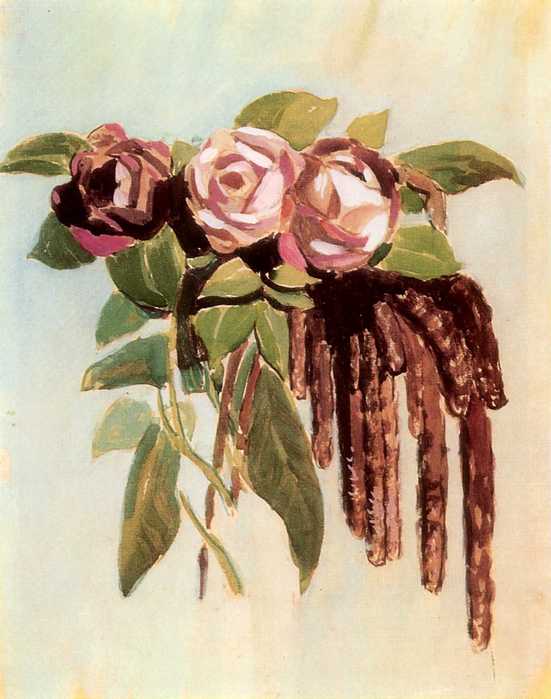
Ale tse bouv velmi is a freakish still life, which is thought by the artists, as it was painted in an empirical manner, not as a closed subject composition. The maestri pictured the details of the still life in the landscape, but it is not the style of life of speeches that is important, but the space itself, the light serpentine, dissolving the outline of objects. Great interest to present also graphic still life M.A. Vrubel, who is growing up with a unique self-confidence.
On the ear of the 20th century, such artists as A.Ya. Golovin, S.Yu. Sudeikin, A.F. Gaush, B.I. Anisfeld, I.S. Schoolboy. A new word in the whole genre having said and M.M. Sapunov, having opened a series of panel paintings with bouquets of flowers.

In the 1900s, before the still life, the impossibility of the artist in the midst of the strains became brutal. Among them there were bullets of the sov. Moscow sezannist, symbolism (P.V. Kuznetsov, K.S. Petrov-Vodkin) and ін. More importantly, the subject composition was taken in the creativity of such vіdomih maistrіv, Yak M.F. Larionov, N.S. Goncharova, A.V. Lentulov, R.R. Falk, P.P. Konchalovsky, A.V. Shevchenko, D.P. Shterenberg, they made a still life equal to the middle genres in Russian painting of the XX century.
One pererahuvannya Russian artists, as in their creativity vikoristovuvali elements of still life took a little time. Tom is surrounded by material pointing here. You can learn more about the still life in the first part of the series of posts about the genre of still life.
Front view: Part 1 -
Part 2 -
Part 3 -
Part 4 -
Part 5 -
Is it still life?
Still life is a genre called painting, within the framework of how to depict inanimate nature... The genre originated in the 17th century.
Still life in pershu chergu, wondrous and tsikaviy tim, which sniffs people to bachiti beauty and harmony in everyday, boring speeches, so that we will feel good all the time, but we do not want to berate our respect on ourselves.
The genre is not so simple, as to be built for the first glance: in a large number of such paintings, artists are victorious to say allegory - to wrap themselves through a singing set of objects, their arrangement, vibrani colors, I will write compositions to tell people more important, to convey those who dearly dumka.
Disregarding the gloom, shifting "nature is dead", The canvases are often bright with bright farbs, they delight the eyes with their originality and chimera, awaken the richness of life and enjoy themselves with a lot of light, and they are beautiful in new.
I have a senseless vision and a view of a still life, for example, thematic-plot, creative, naval-creative, new-born. Also їх podrozdіyayut according to victorious quotations, illumination, color, hour of the visit, the occasion of roasting, etc.
Dutch and Flemish artists became the masters of still life as an independent genre. A small collection of pictures appeared in the Religion Pobut. Also in the era of inception, the genre of expanded genre nabuli pictures of a gloomy character z glibokim philosophical zmistі in dark tones, in the center of the composition, like boules of the skull, candles and deyaki іnshі attributes. Then, step by step, developing, the genre has absorbed all new and new directly and once again, having cut off all the wider expansion in all the stakes of the suspension. Kvіti, books, vegetables and fruits, gifts of the sea, dishes and other objects and pobut - everything knew its own image in the art. Alone with the best vіdomykh artistsіv still lifes steel Ambrosius Baskhart, Migel Parra, Jan Bruegel, Joseph Launer, Severin Rosen, Edward Ladell, Jan Davids de Hem, Willem van Aalst, Cornelis Breeze.
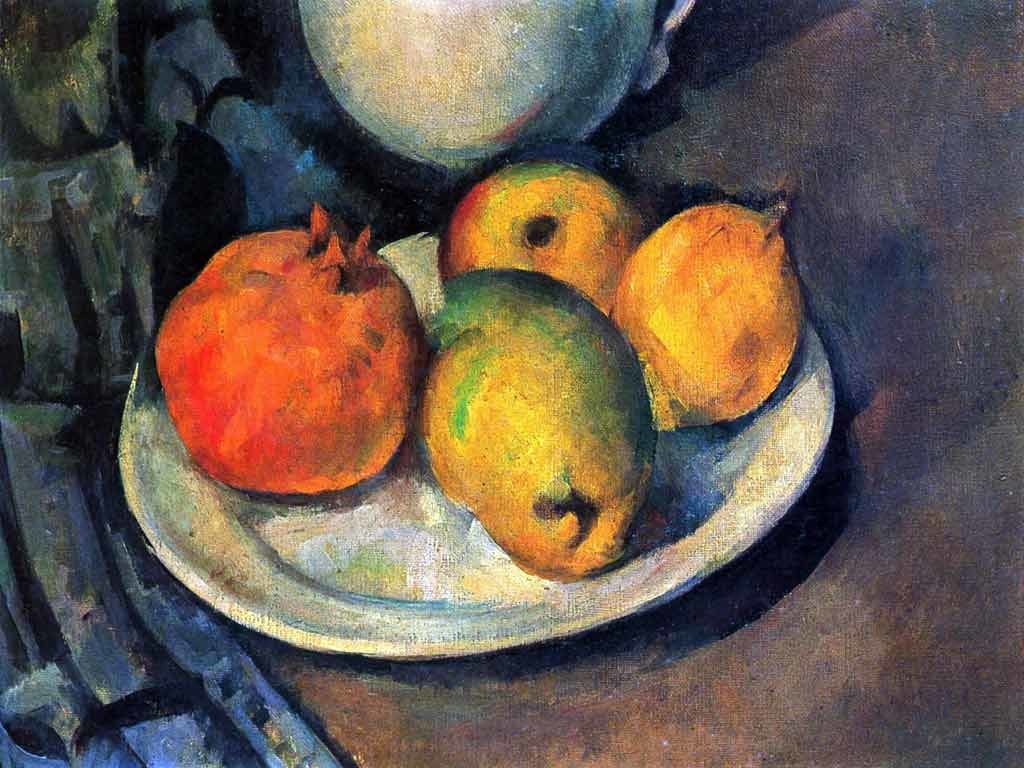 Cezanne, Paul. Still life with pomegranate and pears. 1885-1890
Cezanne, Paul. Still life with pomegranate and pears. 1885-1890  Cezanne, Paul. Still life with apples and oranges. 1895-1900
Cezanne, Paul. Still life with apples and oranges. 1895-1900
Russia has a genre of vinik in on the cob xviii stolittya, ale vserioz cim didn’t take care of it, but got into the “lower” genre. On the ear of the XX century of still-life paintings have reached the most recent development; the artists unveiled their masterpieces, set before themselves new designs and reached the invisible peaks of the majesty, vikoristov removed unknown technologies, picked up new images. Russian still life on the vidminu from the backward development is not deed, but at an accelerated pace. Creativity in a whole genre, such Russian artists became famous, such as K. Petrov-Vodkin, І. Levitan, I. F. Khrutskiy, V. Nesterenko, I.E. Grabar, M. Saryan, A. Osmerkin, P.P. Konchalovsky, S.Є. Zakharov, S.I. Osipov and a lot of them.
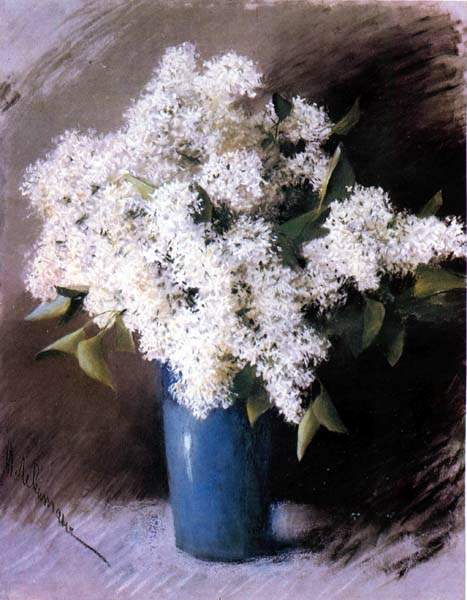 І. Levitan
І. Levitan  І. Levitan
І. Levitan
V bitchy painting still life conceived by the new pidyom and now mitsno borrowed on equal terms with the middle genre imaginative mystery... Infection is one of the most demanded directly in painting. Mayuchi majesty a number of possibilities for self-realization in creativity, artists write beautiful still life. And look, in his own heart, bathe the pictures, adorn them with the interior, enliven their everyday life and bring them into a new calm and joy. The museums are gradually updated with still lifes, all the new and new displays in the new places and countries are displayed, on which new ones come to the new ones, drawn with a mysterious glance. Through a circle of capital, having gone through the whole new development, a still life that was previously relevant and did not lose its significance in the art of painting.
Putting to still life in the era of change, sometimes it was practically forgotten about it, and sometimes it was the most popular genre of painting. As an independent genre of painting, it appeared in the works of Dutch artists in the 17th century. In Russia, for a long time before still life, the yak was put down to the lowest genre, and only by the ear of the 20th century became a new genre. For the choice of history, artists have already created an even greater number of still lifes, and in the middle of the whole series you can see most of them. significant robots for the genre.
"Still life with chink and ordinary dishes" (1 649) by Willem Claes Heda (1594-1682).
The Dutch artist has become the master of the still life, but the same picture is seen in his creativity. Here it is reminiscent of the virtual majesty of Hedi in the transmission of everyday objects by the side - to see the reality of the skin from them. On the table, covered with a rich tablecloth, there is a varto burstin lemon, a piece of fresh shank and a table with a table. Tomorrow it’s just over, so there’s a little bit of disillusionment on the table, so it’s more real to ruin the picture. As well as in most Dutch still lifes this period, here the leather object does not matter as much as it can be added to. So, the most common dishes to talk about earthly riches, the shank means chutta joy, and the lemon is the sumptuous beauty, which prikhovu the inner girkot. Through ts the artist symbolizes us, then think more about the soul, and not just about tilo. The Viconan's painting in Ediniy brown-gray gamy, characteristic of all Dutch painting of the era. Besides the obvious decorativeness, the whole still life is also about the unremarkable "quiet life" of objects, as if recalling the respectful look of the artist.
Peaches and Pears (1895) Paul Cezanne (1830-1906).

Make the genre of still life conservative. It is practical for that until the ear of the 20th century is seen in the same way in the 17th century. Until quietly, leave for her without taking on Paul Cezanne. Vvzhav, the painter is guilty to objectively convey the action, and the guilty paintings are based on the laws of nature. Cezanne pragmatic to convey to us not minliv, but permanent quality of the object, through the synthesis of form and color, uniting form and space. The first genre of still life has become a wonderful object for cich experiments. Leather with objects on still life "Peaches and pears" of images from small houses. So there was a style of bachimo from the top, fruit and a tablecloth to the side, a small table from the bottom, and a glechik vzagal immediately from the other sides. Cézanne is magnetized as accurately as possible to convey the shape and shape of peaches and pears. For many wines, vikorystyє optical laws, so warm vіdtinki (chervonia, rhyme, zhovty, golden) are received by us as permeable, and cold (blakitny, blue, greens) - entering into glib. Therefore, the form of objects on his still lifes does not lie in illumination, but rather shy afterwards. The very fact that Cezanne looks monumental.
"Black on the Tablecloth" (1909) Anri Matiss (1869-1954).
